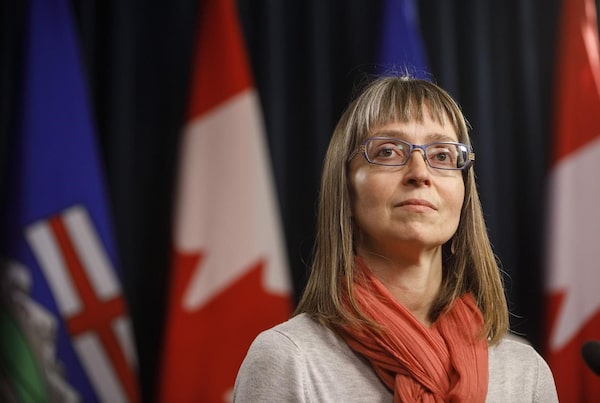
Deena Hinshaw, Alberta’s Chief Medical Officer of Health, seen here in Edmonton on March 20, 2020, announced that testing will also be available to people with symptoms who work in group homes, shelters or as first responders, along with police, bylaw officers and federal and provincial correctional staff.The Canadian Press
Alberta has decided to broadly expand who can get tested for COVID-19 to help curb the spread of disease in high-risk groups, raising questions about whether other provinces will follow suit.
As of Tuesday, anyone in Alberta aged 65 and older with possible COVID-19 symptoms, such as a fever, cough or shortness of breath, is eligible for testing. Deena Hinshaw, Alberta’s Chief Medical Officer of Health, announced that testing will also be available to people with symptoms who work in group homes, shelters or as first responders, along with police, bylaw officers and federal and provincial correctional staff.
“Identifying infections in all of these groups will help us to prevent the spread to high-risk populations living in close quarters, trace any community transmission among the testing groups and provide more valuable information on the effects of our public-health measures,” Dr. Hinshaw said during her daily briefing on Monday.
Infectious-disease experts say testing is a key strategy to containing the spread of COVID-19. Many people with the disease may have mild symptoms and not realize they are ill, meaning they continue to interact with others and spread the infection.
But shortages in test kits and laboratory backlogs have made widespread testing a challenge in Canada. Shortages prompted several provinces, including British Columbia, Alberta and Ontario, to restrict testing criteria to severely ill patients, health-care workers and other high-risk groups.
Despite this, B.C. and Alberta have kept their testing rates high. Alberta, in particular, has been a national leader in COVID-19 testing since the outbreak began, consistently looking for the disease in more people per capita than most parts of Canada and many other countries around the world.
Ontario has faced criticism for its testing rates, which are the lowest per capita in Canada. On Tuesday, Ontario reported testing just 2,568 people the previous day. Provincial health officials have said the province would be able to conduct about 20,000 tests a day by the middle of April.
David Fisman, an epidemiologist at the University of Toronto’s Dalla Lana School of Public Health, said Ontario is testing fewer people than it was last week, “which is exactly the opposite direction we should be going.”
Given that other provinces have been able to scale up testing despite shortages and backlogs, he said he cannot figure out why Ontario has yet to catch up. “I look at this and shake my head.”
On Tuesday, Ontario health officials said the province has capacity to test around 10,000 a day, but that fewer people are showing up to assessment centres. The province hopes to increase the numbers of those tested, and an expert group is going to advise officials on next steps for the province’s testing strategy, said Barbara Yaffe, Ontario’s associate chief medical officer of health.
“Obviously, we have a lot of capacity that we want people to be tested but we don’t want to go overboard and end up with another backlog,” she said.
In Alberta, Dr. Hinshaw said the province is expanding who can be tested because the outbreak is evolving and it is clear that people who live in close quarters, such as in group homes, long-term care facilities, jails and other institutions, are at a heightened risk.
Sign up for the Coronavirus Update newsletter to read the day’s essential coronavirus news, features and explainers written by Globe reporters.
 Carly Weeks
Carly Weeks